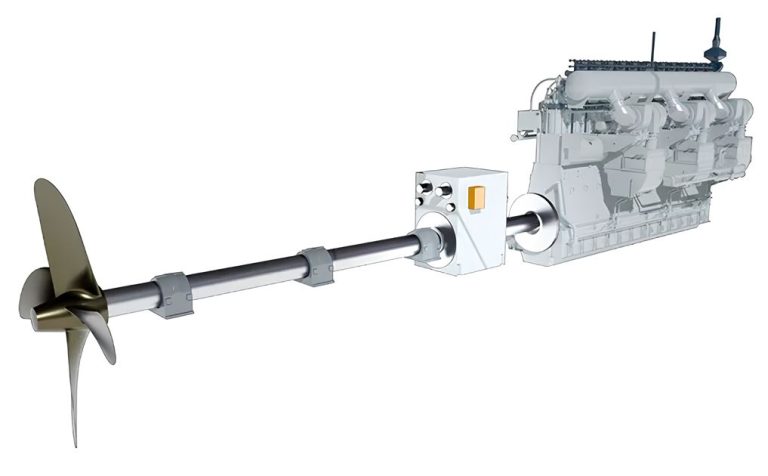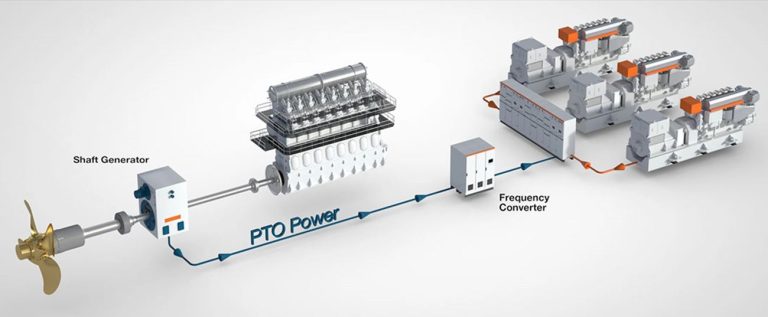Cruise Industry: The Hybrid Shaft Generator
The Hybrid Shaft Generator (HSG) is a marine propulsion system available for many years, designed to offer significant advantages to the ships on which it is installed. This system generates electrical power from the propulsion engines instead of traditional electrical generators.
The features of the HSG offer multiple advantages over a conventional diesel-electric system: it optimizes onboard energy production, reduces fuel consumption (by up to a significant 8%), and lowers emissions.
Additionally, such a system allows for space recovery on board. Currently, the engine room comprises both diesel engines for power generation and propulsion engines. With the HSG, a single engine handles both propulsion and power generation. The installation of azipods had already reduced engine room space, as this system eliminates traditional propeller shafts. The propulsion motor is located in a pod, which can rotate 360 degrees (also serving as a rudder) and has the propeller installed on it.
Shaft Generator System
Currently, the cruise industry is divided into two camps: azimuthal propulsion (diesel engine + pod) and traditional propulsion (diesel engine + electric motor). Will manufacturers be able to convince some shipowners to take this step, at least on ships with more limited electrical loads? The HSG has been on the market for some time now, and its reliability is proven, but so far, large cruise ships have opted for the two aforementioned solutions.
Today, several manufacturers boast HSG systems in their portfolios, one of them being Wärtsilä. The Finnish company has identified the ferry segment as a key area in the transition towards hybrid and fully electric ship operations. Integrating a hybrid shaft generator system with onboard energy storage on a large RoRo or RoPax ship offers optimized engine load and the opportunity to generate electrical power from the main engine instead of auxiliary ones. With significantly reduced fuel consumption, maintenance requirements, and emissions, this approach seems a logical choice.
Wartsila Shaft-generator
Ferry operators are under pressure to improve efficiency, reduce operating costs, and decarbonize to comply with stricter emissions legislation. Compared to other types of ships, however, ferries are particularly well-positioned to benefit from hybrid shaft generator systems. Cruise ships, which have higher hotel loads and installed power exceeding 60 MW on large vessels, currently prefer to generate power with diesel engines, which can be dual fuel at best.
In ferries, auxiliary engines are traditionally used to power the thrusters needed for port maneuvers and to provide hotel loads, the energy required to operate non-propulsion systems such as air conditioning, lighting, and refrigeration. With the HSG, both of these needs can be met by batteries alone, which currently cover more limited loads compared to propulsion needs. However, this already provides significant advantages during port stops and when entering or leaving the port or sailing in slow traffic areas, where emissions and noise must be kept below specified limits.
Shaft Generator Wartsila
The HSG today thus contributes to significantly reducing, and in some cases even eliminating, the need for auxiliary engines and the related emissions. “Energy storage decouples energy production from consumption, meaning that onboard energy production resources can operate at maximum efficiency, providing instantaneous power as needed and improving redundancy, load response, and power availability,” says Michael Kranz, General Manager of Wärtsilä’s Shaft Generator System. “When integrating onboard battery energy storage, instead of starting auxiliary engines solely to charge the batteries, it is much more efficient to use an HSG system that, driven by the main engine, provides power at constant voltage and frequency even if the ship’s speed or propeller speed changes due to sea conditions.”
Research in the maritime transport field is always seeking new solutions to move the sector towards the “carbon neutral” goal for 2050. If progress continues at this pace, this goal may be achieved before that date. Currently, the most virtuous sector is cruise ships, followed by ferries and finally merchant ships. Even the not-so-new HSG technology can contribute to this goal; we have only one planet, and the sector has the moral duty to leave future generations a cleaner sea.
Stay tuned for news, updates, and reviews on the world of cruises on Cruising Journal with photos, videos, and cruise offers.



